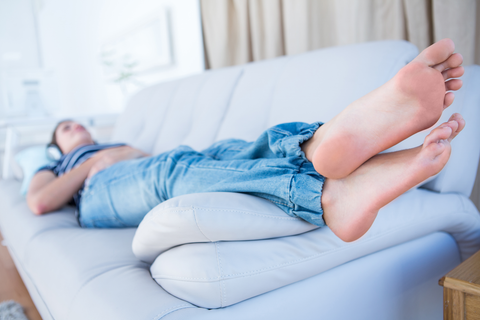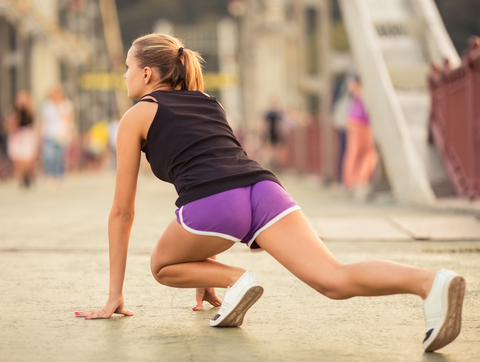Studies show that the rate of lower body injuries in runners ranges from 19.4% to 79.3%, with hip injuries occurring in 3.3% to 11.5% of cases. If you run regularly, your risk of hip injury is even higher. Untreated, these injuries can become chronic. In this guide, we'll walk you through how to relieve hip pain effectively. Let's get started.
What Causes Hip Pain After Running?
Credit: Envato Elements/ s_kawee
Hip pain from running usually happens because of overuse, bad running form, or unsuitable shoes. When you run, your hip joints and muscles repeatedly get stressed, which can cause injuries like strained muscles, hip bursitis (inflammation of the cushioning pads in your hip joint), labral tear (cartilage surrounding the hip joint tears), or tendinitis (inflammation of the tendons).
This sharp pain can greatly affect your running and daily activities. It can impact the way you walk and limit how well you move. If not treated early, hip pain can get worse and lead to more serious problems, including injuries to your back and knees.
How to Treat Hip Pain from Running
Here are some effective methods for treating hip pain from running:
1) Get Plenty of Rest
Credit: Envato Elements/ Wavebreakmedia
To treat hip pain from running, the first step is to rest. Continuing to push through the pain can worsen the issue and lead to more severe injuries. Avoid running and other high-impact activities until the pain subsides. If you still want to maintain a workout routine, go for low-impact activities like swimming or cycling instead.
2) Try Ice and Heat Therapy
Use ice packs on the affected area for the first 48 to 72 hours after you feel pain. This will help reduce inflammation and numb the sore tissues. Do this for 15 to 20 minutes every few hours.
After the initial few days, switch to heat therapy. Use a heating pad or a warm towel to help relax and loosen the tissues and stimulate blood flow to your hip. Like with the ice pack, apply heat for about 15 to 20 minutes.
3) Try Stretching and Strengthening Exercises
Credit: Envato Elements/ LightFieldStudios
Stretching and strengthening exercises will help you strengthen your hip muscles, manage any pain, and even prevent future injuries. A good stretch to try is the hip flexor strain stretch: step one foot forward into a lunge position, keeping the other knee on the ground. Lean into the lunge, pushing your hips down toward the floor, and hold for 20-30 seconds. You should feel a stretch in the upper thigh bone of your leg that's behind you and your hip flexors.
For strengthening, focus on exercises that build the muscles supporting your hips. Bridges are effective: lie on your back with your knees bent and feet flat on the ground. Lift your hips toward the ceiling, squeezing your glutes and core as you go, then lower back down. Perform 10-15 repetitions.
4) Use OTC Painkillers
Medications like ibuprofen, aspirin, or acetaminophen can help reduce inflammation and alleviate pain. Always follow the dosage instructions on the package and be mindful of how often you take them. It's important to follow the dosage instructions on the package carefully to avoid any side effects. If the pain persists despite taking OTC painkillers, consider consulting a healthcare professional to check for stress fractures. Remember, these drugs are for temporary relief and should not replace other treatments like rest, ice, heat, and exercises.
5) Try Physical Therapy
Credit: Envato Elements/ lithiumphoto
Despite doing everything, if your pain refuses to leave, consider trying physical therapy. A physical therapist can design a treatment plan tailored to your specific condition. They can also check for a stress fracture and guide you through exercises that improve flexibility and strength of your hip muscles. Physical therapy often includes a combination of manual therapy, such as massage, along with targeted exercises.
6) Try Using Massage Balls
Massage balls target tight muscles and trigger points to release tension and improve blood flow which can be really effective if you're dealing with hip pain. To use a massage ball, place it on the ground and slowly lower the affected area of your hip onto the ball. Use your body weight to apply pressure and roll the ball around the painful area. Do this for about 30 seconds on each spot.
How to Prevent Hip Pain from Running
Here are some effective methods to prevent hip pain from running:
1) Warm Up Before Running
Credit: Envato Elements/ GeorgeRudy
The first thing you need to do is warm up before running. Start with five to ten minutes of light aerobic activity, like brisk walking or slow jogging, to gradually raise your heart rate and increase blood flow to your hip flexor muscle. After your body feels warmer, include dynamic stretches such as leg swings, walking lunges, and high knees. This will help loosen the muscles around your hips and prepare them for the impact of running.
2) Maintain a Proper Running Form
To maintain a proper running form, keep your posture upright and your body relaxed. Avoid leaning forward too much; instead, align your head, shoulders, and hips. Your arms should swing naturally with a slight bend in the elbows, and your hands should be relaxed, not clenched into fists. Make sure your foot lands directly under your body with each step, not ahead of it. This helps reduce the impact on your hips and other joints. Also, try to run with a smooth stride to minimize bouncing, which can increase the stress on your hips.
3) Use Proper Footwear and Equipment
Credit: Envato Elements/ YuriArcursPeopleImages
Choose running shoes that provide adequate support and cushioning for your foot type and running style. It's important that your shoes match your gait, whether you pronate, supinate, or have a neutral stride. Visit a specialty running store to get fitted for shoes based on your running mechanics. Also, replace your shoes every 300 to 500 miles to ensure they continue to offer the support you need.
4) Increase Your Muscle Mass
Stronger muscles support and stabilize your joints, reducing the risk of injuries. Focus on building strength in your core, hips, and legs. Exercises like squats, lunges, and planks are particularly beneficial as they target multiple muscle groups that are essential for running. Include strength training into your routine two to three times per week, allowing rest days between sessions for muscle recovery.
Summary
Managing hip pain from running requires careful attention, but with the right strategies, you can ease your discomfort and avoid further injuries. Make sure to rest adequately, listen to your body's signals, and get professional advice when necessary.
Looking for a simple way to enhance your recovery? Try Acupoint massage balls. They're perfect for targeting those tight spots and helping your muscles relax after a run. Shop with us today.


















